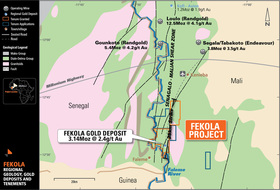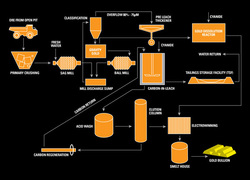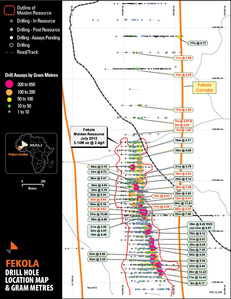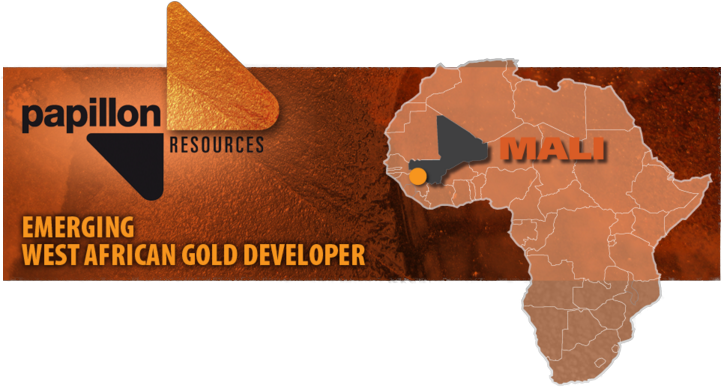FEKOLA GOLD PROJECT

Papillon’s work program at Fekola is aimed at fast tracking the appraisal and exploration of the widespread gold mineralisation identified within the Project area to enable the Company to fulfil its strategic objective of becoming a Western African gold producer in the near-term.
SCOPING STUDY
A comprehensive Scoping Study was completed on Fekola in October 2012.
Utilising the current Mineral Resource Estimate (‘MRE’) of 40.1 million tonnes of ore at an average grade of 2.4 g/t for a contained 3.14 million ounces of gold as a base case scenario, the Project can support an average annual production profile of 231,000 ounces of gold over a minimum eleven year mine life. There is strong potential to increase the production profile and mine life with ongoing exploration work.
- Average annual production of 231,000 ounces gold for Life of Mine (‘LOM’);
- Average annual production of 245,000 ounces gold during Steady State operations;
- Initial mine life of eleven years (nine years Steady State), with strong potential to increase;
- Life of mine average operating costs of US$596 per ounce of gold;
- Capital cost, including all associated project infrastructure, of US$298 million; and
- Pre-Feasibility Study to commence immediately, targeting completion in Q2 2013.
Table 1: Fekola Project – Mineral Resource Estimate as at July 2012
|
Indicated Resource
Inferred Resource Total Resource |
Tonnage
(million tonnes) 10.5
30 40.1 |
Grade (g/t gold) 2.75
2.3 2.4 |
Contained Gold
(million ounces) 093
2.21 3.14 |
The resource is estimated on a 100% basis of which 90% is attributable to Papillon Resources Limited
All figures are rounded to reflect appropriate levels of confidence. Apparent differences occur due to rounding
MINING
Whittle optimisations were completed on the MRE. Materials classified in the Indicated and Inferred categories were used in the optimisation process, with the results used to develop the life of mine (‘LOM’) mining schedule. Inputs for the Whittle optimisation process included:
- US$1,300 per ounce gold price
- 10% discount rate
- 5% mining dilution and 95% mining recovery
- 90% processing recovery
- Pit wall angles of 52 degrees
- Lower cut-off grade of 0.70 g/t gold
The mining schedule is expected to be conducted over a period of 11 years, including an initial 2.7 million tonne pre-strip. At its peak, the mining schedule contemplates the movement of 16 million tonnes per annum (both waste and ore).
Strip ratios for the Project are low, with the average LOM strip ratio being 1:1.9 (ore to waste). The mining schedule has been limited to four 10m benches per year, with a maximum vertical descent of 40m per annum.
At this early stage, the Company has not contemplated any mining optimization, stockpiling of lower grade material, nor the use of a run of mine (‘ROM’) stockpile to blend ore to the mill. These may be contemplated as part of the Pre-Feasibility Study, which has commenced.
METALLURGICAL TEST WORK AND PROCESSING

The Company has completed extensive batch metallurgical test work on a 1.5 tonne representative bulk sample from the Fekola deposit. The comprehensive program addressed all key components including gravity recoveries, leach recoveries at different grind sizes and comminution. The test work program, which formed an integral part of the Scoping Study, produced the following key results:
- The ore at Fekola is amenable to Gravity Recoverable Gold concentration to recover liberated free gold within the milling circuit;
- Direct cyanidation gold recovery averaged 93.3% after processing in a Carbon in Leach mode for 24 hours (leach feed grind size of 80% passing 75 micron);
- Encouraging leach kinetics with rapid leach times i.e. 90% gold dissolution within 10 hours;
- Average standard Bond Rod and Ball Mill Work Indices of 24.5 and 20.4 kWh/tonne respectively. Based on these preliminary results, the ore is described as hard and moderately abrasive; and
- Cyanide and lime consumptions within normal ranges of 0.4-0.7 kg/t and 0.5-0.8 kg/t respectively.
The favourable metallurgical test work results indicate that a simple well understood processing circuit, including Gravity Recoverable Gold (‘GRG’) by Gravity Concentration and a conventional Carbon in Leach (‘CIL’) process are best suited to the Project. The initial conceptual process flow sheet is shown below.
Further work will be completed to refine the conceptual process flow sheet and this will ultimately be followed-up with further metallurgical test work campaigns.
INFRASTRUCTURE
Regional road infrastructure has improved significantly since the construction of a multi-lane, tar sealed Millennium Highway. The highway extends from the port city of Dakar in Senegal to Bamako and is a major supply route for the landlocked country of Mali. The highway passes within 45km of the Project area. The remaining access is not suitable for heavy vehicles and requires upgrading prior to the start of construction. Some of this upgrade work has already commenced, including the construction of culverts and bridges over seasonal waterways to allow year round access to the site.
Water is available from the Faleme River, a major water course with significant year round water flows, which is in close proximity to the Project (within 2km).
CAPITAL COSTS
OPERATING COSTS
The operating costs were estimated in conjunction with the scoping study process design criteria, block flow diagram, mechanical equipment lists, metallurgical test work results for reagents and in-country labour cost data and reagent and fuel supply prices. Operating costs are defined as the direct operating costs including contract mining, processing, tailings storage, water treatment and general and administration.
ENVIRONMENTAL AND SOCIAL IMPACT ASSESSMENT (‘ESIA’)
The work for the ESIA has run concurrently with the Scoping Study and will continue to run in parallel with the Pre-Feasibility Study. The ESIA will form an integral part of the Company’s application for a mining permit (‘Permis D’Exploitaition’), which is anticipated to be submitted mid 2013.
The ESIA includes, but not be limited to, the following key items:
- Environmental baseline monitoring programs including groundwater monitoring, run-off, air quality, noise monitoring and water ways;
- Census work to understand flora and fauna at the Project;
- Ecosystem sensitivity surveys;
- Community engagement and census work; and
- Resettlement Action Plans, if required.
PRE-FEASIBILITY STUDY AND DRILLING

The drilling completed at Fekola to-date extends over a strike length of approximately 2km, which represents a small portion of the strike extent of the highly prospective Fekola Corridor, and extends to a maximum vertical depth of 260m. Mineralisation remains open at depth and along strike to both the north and south. The next drilling campaign, scheduled to commence in mid November 2012 and include in the order of 100,000m, will be focussed on upgrading the resource classification and expanding the current MRE, as well as testing priority targets along the Fekola Corridor. An increase in the overall resource base will facilitate future expansion in production rates and the contemplation of a longer mine life for the Project.
The rapid progression to a PFS will further de-risk the Project and move the Company closer to its stated goal, of being a West African gold producer in the near term.
